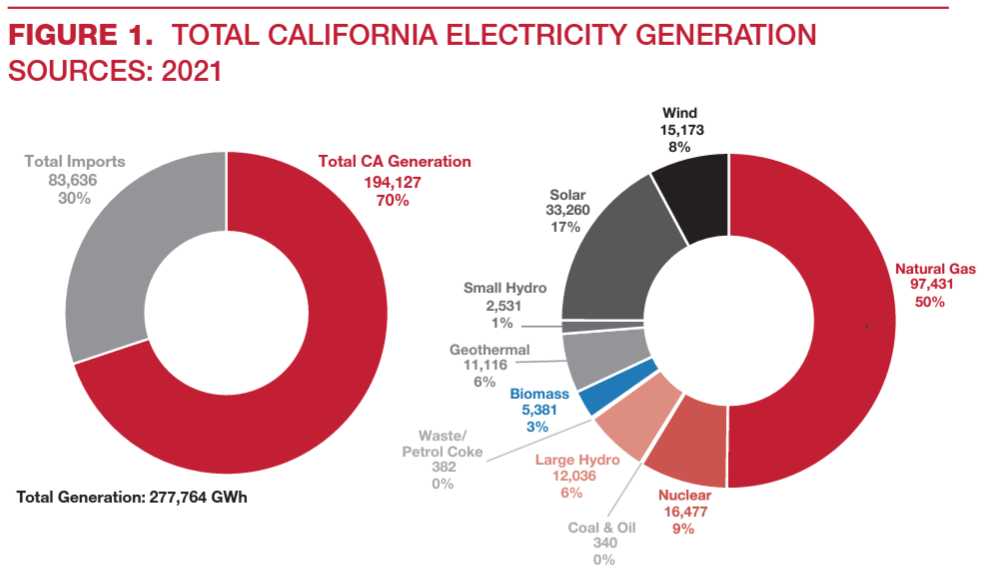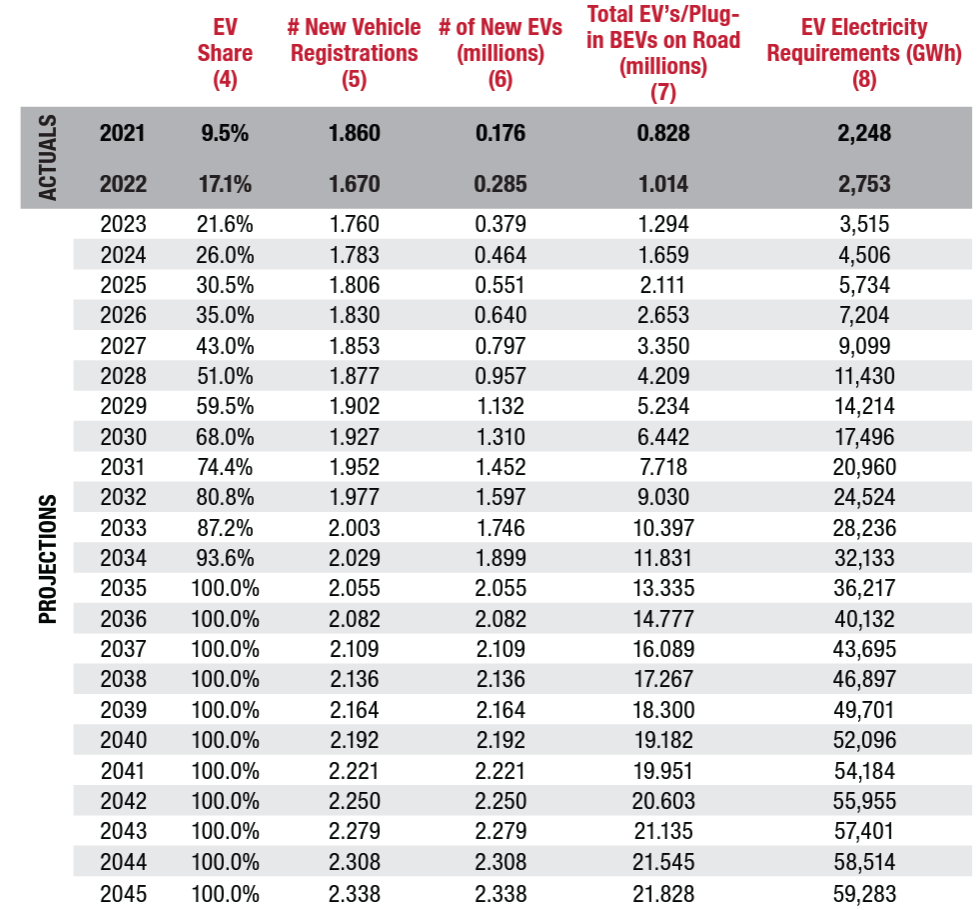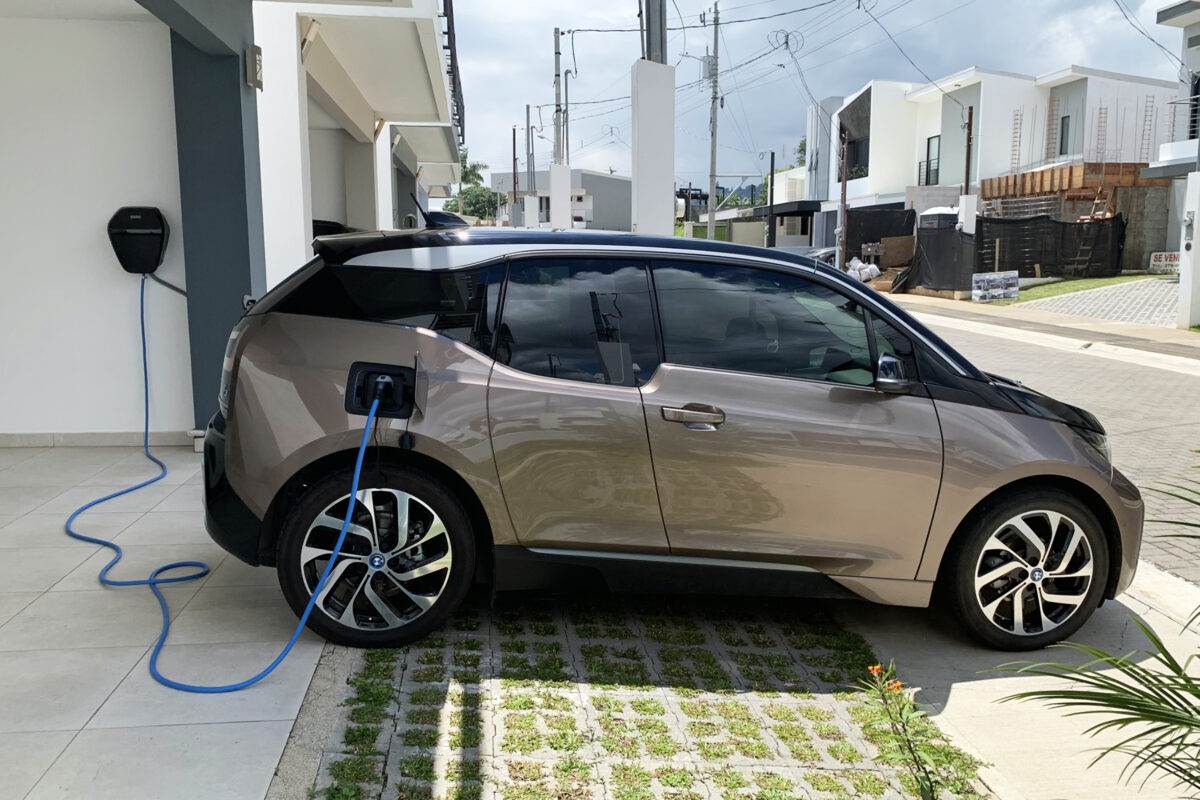The State of California could fall 21.1% short of the electricity demand required to meet the most populous U.S. state’s bold goal of its consumer and commercial transportation fleet becoming powered entirely by electric vehicles (EV).
That shortcoming is detailed in a report by the Pacific Research Institute, a Sacramento-based nonprofit and think tank formed in 1979.
In September 2020, California Governor Gavin Newsom signed an executive order requiring all new passenger cars and commercial light trucks sold in California to be zero-emission vehicles by 2035. In August 2022, the California Air Resources Board or CARB approved the governor’s mandate, setting the state on a bold mission to supply clean energy into the grid to power its 40 million residents’ homes, businesses as well as vehicular fleet.
After the CARB vote, grid operator the California Independent System Operator (CAISO) then sent a dispatch called the Flex Alert to the state’s EV drivers to request that they refrain from charging their vehicle during the peak evening hours of 4 p.m. to 9 p.m. Pacific time. CAISO then expanded its memo to request homeowners curtail the use of household appliances like washer and dryers at the same time.
“California’s green energy mandates will require families and businesses to consume more energy from the electricity grid instead of fossil fuels, making it less likely that we can generate the necessary power,” said Dr. Wayne Winegarden and Kerry Jackson, the authors of the PRI report. “These policies jeopardize California’s energy security and, without a miracle leap in technology, set us up for future energy shortages.”
Assuming all other residential electricity consumption remains flat—a trend ongoing since 2006—PRI’s calculations find that California will require a 20.2% expansion of electricity generation, from nearly 280 TWh to an estimated over 336 TWh to meet its EV mandates and additional residential electric charging required by 2045.
The report highlights California’s phase out of nuclear and natural gas, among other fossil fuel facilities, is the leading source of the state’s 21.1% deficit of power generation to demand by 2045.

The PRI report, titled “Sapping California’s Energy Future,” explores how implementing the EV mandate combined with other state green mandates will create avoidable energy shortages. Analyzing state data and conducting their own calculations, PRI found that:
- Two-thirds of current electricity comes from disfavored sources: Nearly 60% of current power generation comes from natural gas and nuclear power.
- Total electricity generation will be 21.1% short of projected demand: Assuming that other state residential electricity consumption remains flat—California will require a 20.2% increase in electricity generation to meet the EV mandates and increased charging demand.
- Deficit much worse when other green mandates factored in: The actual electricity generation deficit will likely be worse, as the PRI report does not factor in additional demand to meet other green mandates, such as prohibition of gas-powered heaters and air conditioner units.
- State will have to increase annual addition of clean energy by 86%: To meet government-imposed renewable energy transition deadlines, California will have to expand its annual addition of renewables by 86%.
Winegarden and Jackson suggest that California should repeal its green mandates and instead promote market-based climate change policies. They conclude that Sacramento should embrace technologies that are efficient today and will promote the innovations required to secure a low-emission energy system.
“Energy policy should not be crafted based on the whims of a few hundred policymakers who want to design the future,” said Winegarden and Jackson. “Sacramento must prioritize promoting innovation to meet California’s clean energy goals while keeping energy abundant and affordable.”
According to the PRI’s chart below, referencing the state’s energy department data from 2021, the state continues to import 30% of its energy needs from neighboring states. With baseload generation from remaining nuclear, gas and coal resources to be shut down by 2045, the state will still fall short of meeting demand forecasts.
Renewable sources are defined as biomass, solar thermal, photovoltaic, wind, geothermal, fuel cells and hydro generation of 30 MW or less, plus renewable natural gas, solid waste conversion and tidal energy.
Of the favored energy sources, solar and wind generation are the only growth sources in California. Geothermal, hydro, and bioenergy have been in overall decline over the past two decades. In practice, solar and wind will need to generate nearly all the renewable power for the state’s energy transition.
With sufficient energy storage included, the excess electricity generation that occurs on sunny and windy days can be stored. For California, CAISO estimates that meeting its 2045 objective requires 37 GW of energy storage, 4 GW of long-duration storage, over 53 GW of utility solar, 2 GW of geothermal, and over 24 GW of wind turbines, split between in and out-of-state wind power. Total renewable generation capacity needed by 2045 is 120.8 GW, PRI reports.

EV surge imbalance
Based on EV data from Pew Research and CarInsurance.com, PRI said that by 2035 there will be 13.4 million EVs on California’s roads, which is similar to CalMatters’ estimate of 12.5 million EVs by 2035.
Continuing through 2045, there will be 21.8 million EVs in the state. Charging these EVs will require a 21-fold increase in the amount of electricity, from an estimated 2.75 TWh in 2022 to an estimated 59.3 TWh in 2045. Since the 2.75 TWh of electricity used to charge EVs in 2022 is already accounted for, meeting California’s current EV mandates requires an additional 56.5 TWh of electricity over the current electricity consumption projections timeframe, as seen in Table 1 above.
This content is protected by copyright and may not be reused. If you want to cooperate with us and would like to reuse some of our content, please contact: editors@pv-magazine.com.









I’m not an expert by any means, but to achieve the 2045 target some changes need to be made. NEM 3.0 is going to have to go through some major iterations in order to get far more rooftops onto the grid. Not just residential locations where the vehicles are parked at night, but the destinations of those vehicles so they can charge during the day. So get ready for NEM 3.1 and if that isn’t working NEM 3.2, etc until the trend to goal is in sight. If the trend doesn’t come by the end of this decade, they will have to have another look at Nuclear.
With NEM1.0 and NEM2.0 Californian’s added 1.4 million rooftop solar systems removing their loads from the grid during daylight hours and putting an additional large quantity of their extra power onto the grid. Utilities told EV owners to charge at night so they could sell them fossil fuel generated power to keep the old fossil fueled power plants relevant. Batteries are expensive and are getting even more expensive. The Tesla power wall has gone up from $6.000.00 each to $12,000.00 over the past 4 years making them more expensive than the solar panels plus labor. for a home. The new competitors are also raising prices because of the NEM3.0 CPEC decision. The rooftop solar was keeping up with electrical demands for EV charging but NEM3.0 will kill the rooftop solar industry in California just as it did in Nevada 6 years ago. Pairing rooftop solar with bi-directional EV charging could save both the consumer and the grid but Tesla and others refuse to go along with Bi-directional charging EVs that let the car’s battery act as the home electrical storage system as well as power the EV.